Bring the quintessential steakhouse experience home with this incredibly rich and creamy creamed spinach recipe. Featuring tender, vibrant spinach leaves enveloped in a luxurious, garlic-infused béchamel sauce, this dish is the ultimate side for your favorite steaks, roasted chicken, delicate seafood, and so much more. Elevate any meal into a gourmet dining event with this surprisingly simple, yet utterly indulgent, classic.
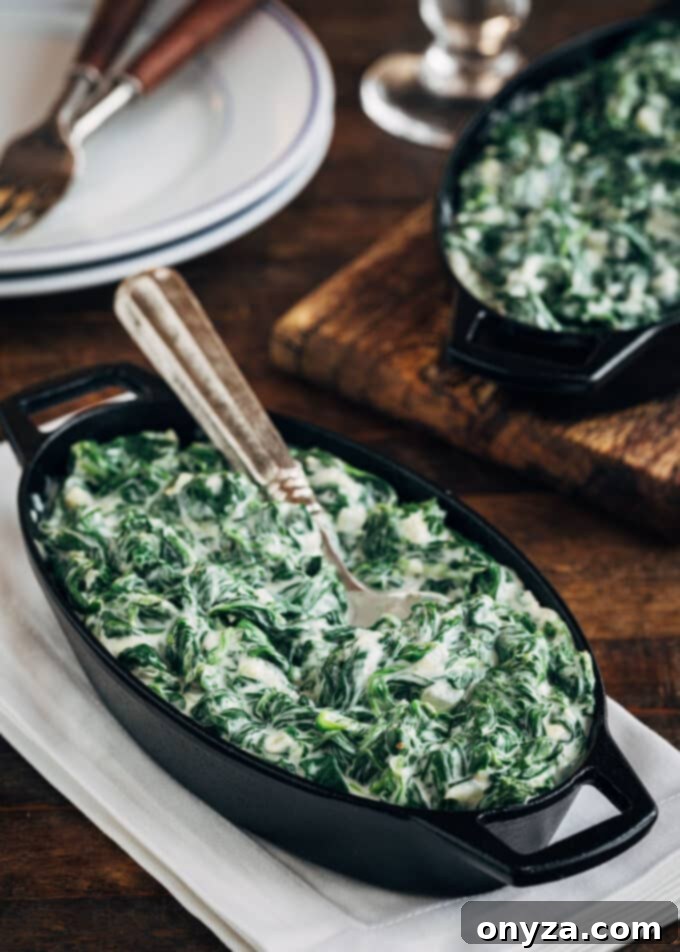
Mastering the Art of Creamed Spinach: A Steakhouse Classic at Home
For many, a visit to a great steakhouse is incomplete without an extravagant array of side dishes. While sizzling, perfectly cooked steaks often steal the show, the supporting cast of creamy mashed potatoes, earthy sautéed mushrooms, and, of course, the classic creamed spinach, truly completes the feast. This beloved side dish is a cornerstone of the steakhouse experience, known for its indulgent yet comforting nature. It’s special enough for a celebratory meal, yet wonderfully cozy and down-to-earth, inviting you to savor every forkful between bites of a juicy prime rib or a succulent filet mignon.
The good news is that recreating this essential component of a fine dining experience is much easier than you might think. With a few simple tips and tricks, you can bring the luxurious flavor and satisfying texture of steakhouse-quality creamed spinach right to your own dinner table. Get ready to impress your family and friends with a side dish that’s guaranteed to become a new favorite.
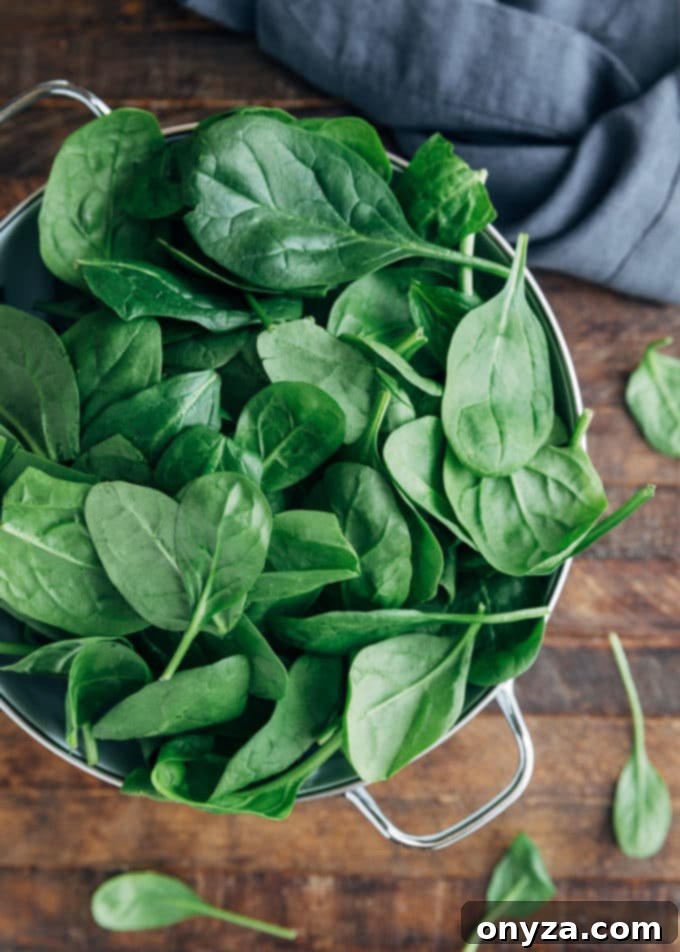
Choosing the Perfect Spinach for Your Creamed Spinach Recipe
The foundation of outstanding creamed spinach begins with the right type of greens. While several varieties of spinach can be used, your choice will influence the final texture and flavor of your dish. Understanding the characteristics of each type will help you achieve your desired result.
Baby Spinach: For a Delicate and Tender Result
I frequently opt for baby spinach in my creamed spinach recipe, and for good reason. These young leaves are exceptionally tender from leaf to stem, requiring minimal preparation and offering a slightly sweeter, milder flavor compared to their more mature counterparts. Their delicate nature means you typically don’t need to chop them after blanching, resulting in a beautiful textural contrast between the elegant ribbons of spinach and the smooth, creamy sauce. This creates a refined eating experience that many find preferable.
However, if you prefer a more uniform, finely textured creamed spinach, you can certainly chop the blanched baby spinach. Just be sure to do this after the blanching and thorough draining process to avoid a watery dish. Baby spinach is readily available in most grocery stores, often pre-washed, which saves a considerable amount of prep time.
Mature Spinach: For a Robust Flavor Profile
For those who appreciate a stronger, more pronounced spinach flavor, bunched, mature spinach is an excellent choice. These larger, heartier leaves have a more earthy taste and a slightly stringier texture. If you choose mature spinach, proper preparation is key. You’ll need to carefully remove any tough stems and give the leaves a very thorough rinse, as mature spinach can often harbor sand and grit. After blanching, it is crucial to chop mature spinach to ensure it integrates well into the sauce and provides a pleasant eating texture.
Regardless of your spinach choice, remember that the quality of your fresh ingredients significantly impacts the final outcome. Look for vibrant, crisp leaves without any signs of wilting or discoloration.
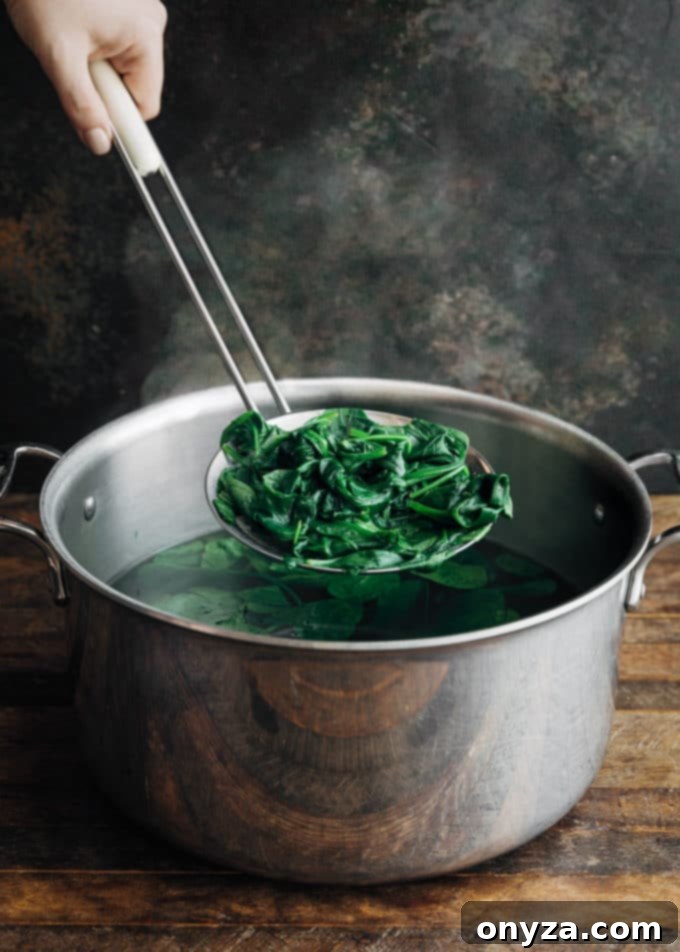
The Art of Blanching Spinach for Optimal Flavor and Color
To achieve the best results for your creamed spinach, I highly recommend blanching the greens. Blanching is a simple yet crucial technique that involves briefly cooking vegetables in boiling water, then immediately transferring them to an ice bath (or rinsing under very cold running water) to halt the cooking process. This method offers several key benefits for creamed spinach:
- Vibrant Color: Blanching brings out and locks in the gorgeous, natural emerald-green coloration of the spinach. Overcooked greens tend to become dull and muted, losing their visual appeal. The quick cooking and shocking in ice water preserve that fresh, vibrant hue.
- Perfect Texture: A brief blanch softens the spinach just enough without making it mushy. It maintains a slight bite that complements the creamy sauce beautifully.
- Reduced Bitterness: Blanching can help reduce some of the oxalic acid found in spinach, leading to a milder, more palatable flavor.
- Volume Reduction: Spinach wilts significantly during blanching, making it easier to manage the large volume of fresh leaves required for this dish.
Essential Step: Draining the Spinach Thoroughly
This cannot be stressed enough: after blanching and shocking, it is absolutely vital to drain the spinach exceptionally well. Excess water is the enemy of creamy spinach. If liquid remains in the spinach, it will leach into your béchamel sauce, making the dish watery, thin, and diluted in flavor. To ensure maximum creaminess, press or squeeze out as much liquid as possible. You can use a fine-mesh sieve, a potato ricer, or even a clean kitchen towel to wring out the moisture. This step is non-negotiable for achieving that thick, luscious, steakhouse-style texture.
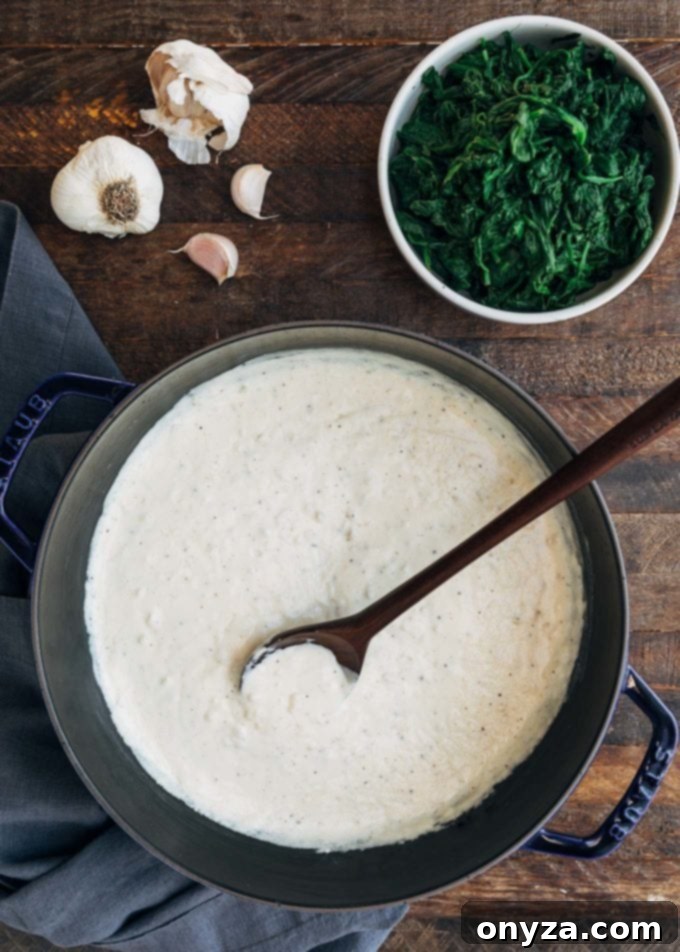
Crafting the Silky Béchamel: The Heart of Creamed Spinach
The luscious cream sauce is what truly transforms humble spinach into an irresistible side dish. Most authentic creamed spinach recipes, including mine, rely on a classic roux-based white sauce, also known as a béchamel. This traditional French mother sauce provides the perfect foundation for a rich, velvety texture and allows for excellent flavor absorption.
My journey to perfect a steakhouse-quality creamed spinach at home involved experimenting with numerous sauce “formulas.” Initially, I was convinced that a generous proportion of heavy cream was necessary to achieve that crave-worthy, silky consistency found in restaurants. However, every time I used heavy cream, the result felt overly rich – almost too heavy to enjoy alongside a hearty steak. (And trust me, “too much” is a phrase I rarely utter in the kitchen!)
Interestingly, I discovered that using commercial half-and-half delivered precisely the right balance. It provided the desired richness and velvety texture without being overwhelming. The sauce remained decadent and luxurious, yet light enough to complement, rather than compete with, the main course. If you prefer an even lighter option, whole milk can also be used, offering a slightly less rich but still wonderfully creamy sauce. The key is finding a balance that suits your palate and pairs well with your meal.

Seasoning Your Cream Sauce to Perfection
Beyond the creamy base, the flavor profile of classic creamed spinach is defined by a few key aromatics and spices. My recipe follows tradition, incorporating finely sautéed onions and minced garlic, which build a deep, savory foundation for the sauce. A hint of freshly grated nutmeg adds a warm, almost sweet earthiness that is a hallmark of good béchamel and perfectly complements the spinach. For a subtle warmth in the background, a pinch of cayenne pepper is a delightful addition – or more, if you enjoy a spicier kick.
While I confess to a profound love affair with cheese, and some steakhouses do include it in their creamed spinach offerings, I typically prefer to keep my béchamel simple, creamy, and garlic-forward. I usually reserve cheese for dishes like Spinach au Gratin, where a crispy, cheesy topping is the star. However, if you wish to add a cheesy dimension, Parmigiano Reggiano is an excellent choice, lending a salty, umami depth without overpowering the dish. You’ll find instructions for this variation in the recipe notes below.
A recent revelation came from a suggestion by a friend, Hugh Preece of FermentedBoss.com, who recommended adding toasted pine nuts. We absolutely adored this addition! Apparently, some high-end steakhouses serve creamed spinach this way, and after tasting it, I sincerely wish all of them did. The pine nuts introduce a fantastic nutty crunch and a delicate, buttery flavor that elevates the dish to another level. It’s a twist I highly recommend trying.
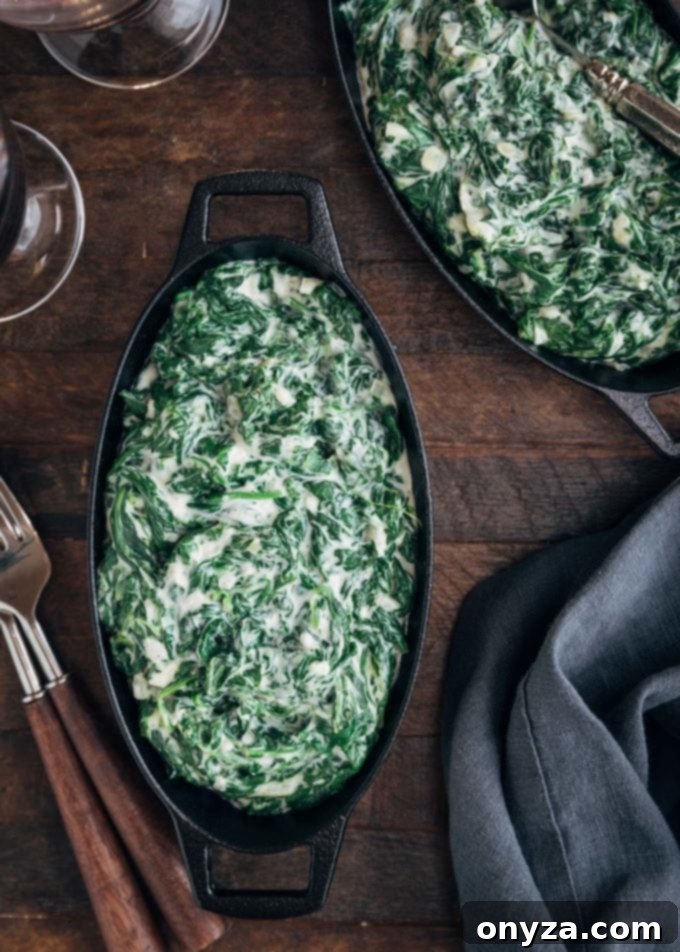
Serving Creamed Spinach: The Ultimate Versatile Side
Creamed spinach is an incredibly versatile side dish that pairs beautifully with a wide array of main courses. Its rich, savory profile makes it a natural complement to classic proteins. Beyond steaks, such as Beef Tenderloin or Slow Roasted Prime Rib, it’s also fantastic with roasted chicken, pan-seared lamb chops, or flaky baked fish. Its creamy texture and vibrant flavor can also be utilized as a delicious stuffing for chicken breasts or pork chops, adding an unexpected gourmet touch to everyday meals.
One important tip for serving: the sauce will naturally thicken as it cools. For the best experience, I recommend keeping your creamed spinach warm until you’re ready to serve. If you’ve prepared it ahead of time and it has cooled too much, you might need to thin the sauce slightly with an extra splash of milk or half-and-half, stirring gently until your desired consistency is achieved. Adjusting by eye is usually the best approach here.
For an elegant presentation and to keep the dish warm at the table, consider serving your creamed spinach in pre-warmed gratin dishes, whether ceramic or cast iron. Just a friendly warning: similar to steakhouses, be sure to alert everyone at the table that these dishes will be hot!

Classic Steakhouse Creamed Spinach Recipe
by Amanda Biddle
Creamed Spinach is a quintessential steakhouse side! See how easy it is to make this rich, delicately-flavored dish at home with fresh spinach and homemade cream sauce. Don’t miss the variations in the recipe notes for customization ideas!
Prep Time: 20 minutes
Cook Time: 20 minutes
Total Time: 40 minutes
Servings: 4 to 6 servings
Ingredients
- 2 pounds spinach leaves, cleaned (baby spinach for tender texture, or mature spinach – see notes)*
- 2 cups half and half (or whole milk for a slightly lighter sauce)
- 6 tablespoons unsalted butter
- 3 tablespoons all purpose flour
- ½ cup finely chopped yellow onion
- 4 cloves garlic, minced
- ⅛ teaspoon freshly grated nutmeg
- Pinch cayenne pepper (optional, for a subtle heat)
- Kosher salt and freshly-ground black pepper, to taste
Instructions
- Bring a large pot of lightly-salted water to a rolling boil. Blanch the spinach in 2-3 batches (depending on your pot size), cooking just until tender (about 30-40 seconds). Using a slotted spoon or spider, transfer the blanched spinach leaves directly into a bowl of ice water to cool immediately and stop the cooking process.
- Drain the spinach exceptionally well. Press or squeeze out as much excess water as possible using a fine-mesh sieve, a potato ricer, or a clean kitchen towel. (This step is crucial for creamy, non-watery spinach!) If using mature spinach or if you prefer a smoother texture, roughly chop the spinach after draining.
- In a large pot or deep skillet, melt the unsalted butter over medium heat until it begins to foam and the foaming subsides. Add the finely chopped onions along with ½ teaspoon of kosher salt and ½ teaspoon of black pepper. Sauté until the onions become soft and translucent, about 4-5 minutes. Add the minced garlic and cook for an additional minute until fragrant, being careful not to burn it.
- Stir in the all-purpose flour and cook, stirring continuously, for 1 minute. This creates the roux. While continuing to stir vigorously with a whisk, gradually pour the half and half (or whole milk) into the pot in a steady stream to prevent lumps. Add an additional ½ teaspoon of kosher salt, ⅛ teaspoon of freshly grated nutmeg, and the cayenne pepper (if using). Bring the mixture to a gentle boil, then reduce the heat to a simmer and cook, stirring occasionally, until the sauce has thickened and coats the back of a spoon, typically 3-4 minutes.
- Add the well-drained spinach to the pot with the cream sauce. Stir thoroughly until all the spinach leaves are evenly coated with the rich sauce. This might take a bit of stirring. If the sauce appears too thick, you can add a small splash of extra milk or half and half until your desired consistency is reached.
- Taste and season with additional kosher salt and freshly-ground black pepper as needed. Serve immediately in pre-warmed dishes for the best experience.
Notes
- *Baby spinach offers a more delicate flavor and tender texture, resulting in a milder dish. If you prefer a more robust spinach flavor, use regular/mature spinach leaves. Ensure they are thoroughly cleaned and any tough stems are removed if buying in a bunch. Regular spinach should be chopped after blanching.
- You can also substitute an equal quantity of frozen chopped spinach. Make sure to cook it according to package directions and drain it very, very well to remove all excess moisture.
Variations:
- Make it Cheesy: Stir ½ cup (or more, to taste) of finely grated Parmigiano Reggiano cheese into the sauce just before adding the spinach. Keep in mind that the cheese will thicken the sauce slightly, so you might need to add a little extra milk or cream once the spinach is incorporated. The cheese will also add saltiness, so adjust your salt additions accordingly.
- Make it Smoky: Chop 4-5 slices of thick-cut bacon. Start the sauce by sautéing the bacon until crisp in your skillet or pot. Remove the crisped bacon with a slotted spoon and set aside, leaving only about 2 tablespoons of drippings in the pan. Add ¼ cup unsalted butter and proceed with the recipe as written. Stir the reserved crisped bacon back into the sauce when you add the spinach.
- Make it Nutty: For an additional layer of texture and flavor, stir ½ cup of toasted pine nuts into the creamed spinach just before serving.
Nutrition Estimate
Calories: 393kcal | Carbohydrates: 20g | Protein: 11g | Fat: 31g | Saturated Fat: 19g | Cholesterol: 89mg | Sodium: 232mg | Potassium: 1464mg | Fiber: 5g | Sugar: 2g | Vitamin A: 22220IU | Vitamin C: 67.2mg | Calcium: 367mg | Iron: 6.5mg
Nutrition information is automatically calculated and should only be used as an approximation. Factors such as exact ingredient brands, preparation methods, and serving sizes can vary these values.
Please note that our recipes have been developed using the US Customary measurement system and have not been tested for high altitude/elevation cooking and baking. Adjustments may be necessary depending on your location and specific conditions.
